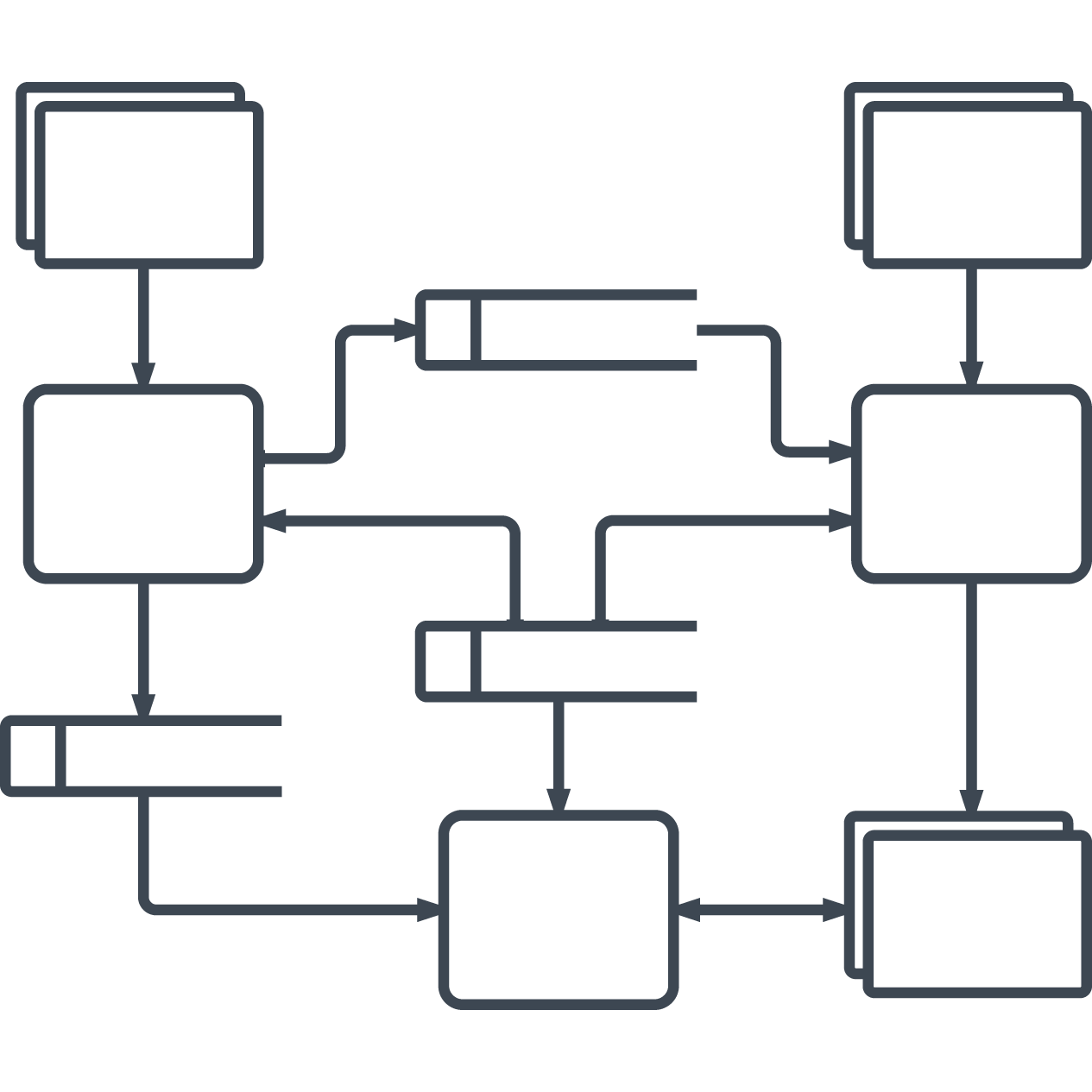
What’s the difference between a business analyst and a data analyst?
Lucid Content
Reading time: about 7 min
Topics:
Every time a user clicks an ad, likes a social media post, shares a picture, streams a movie, and completes a financial transaction, valuable data about that user’s interests, beliefs, purchases, and more is generated.
As of April 2020, there are an estimated 4.5 billion active Internet users. These users generate in excess of 2.5 quintillion bytes of data per day. An analyst is somebody who collects this data from various sources and then breaks it down in an effort to get a better understanding of how the data can benefit their businesses.
All of the information that analysts work with is data. So technically, all analysts could be called data analysts.
It’s understandable why the roles of a data analyst and a business analyst are often confused. However, these are actually two different roles with the main difference being in the way they each use the data. Professor Martin Schedlbauer of Northeastern University describes the differences this way: “In the simplest terms, data is a means to the end for business analysts, while data is the end for data analysts.”
Learn the roles of data analysts and business analysts and how they differ from each other.
What is a data analyst?
A data analyst’s job is to comb through large amounts of data to find trends and patterns. They use statistical techniques to analyze and extract useful information and form conclusions. Then they present the data to the company’s decision-makers who will decide how they will use the data.
In addition, data analysts are responsible for protecting the data, keeping it secure, and ensuring that the data is consistent and reusable.
Data analyst responsibilities include:
- Designing, developing, and maintaining data collection systems and databases
- Troubleshooting problems and fixing code errors
- Mining data from primary and secondary data sources and translating it into a format that can be read by humans or machines
- Writing reports to share findings with senior management and other stakeholders
- Creating graphs and charts so the data can be easily summarized visually
What is a business analyst?
Business analysts also collect data. However, they use the data to strategically find and propose ways to improve processes, procedures, products, software, and services.
For example, a business analyst might take data from a data analyst and use it to figure out where money should be spent. Then the business analyst can make a more informed recommendation to management that money and resources should be invested in Project A instead of Project B.
Business analyst responsibilities include:
- Reviewing and analyzing business processes to formulate objectives and requirements
- Creating workflow charts and diagrams to understand business operations
- Making recommendations for process improvements
- Making recommendations for upgrading or purchasing resources to improve production
- Developing cost estimate models based on projected resource requirements
How do data analyst and business analyst roles differ?
All analysts gather data, break it down, and analyze it for a variety of purposes and to achieve specific goals. However, each analyst role differs from the others depending on the type of data they are collecting and the conclusions they hope to draw from it.
What does a data analyst do?
Data analysts are like detectives. They spend their days collecting, organizing, processing, and analyzing data to figure out what it all means. The goal is to discover useful information that the organization can use to improve processes and increase business.
An important part of the data analyst’s job is to translate the data into stories, usually in the form of written reports, visual charts, and graphs. This part of the job requires data analysts to have excellent communication skills because they will have to present their findings clearly to the company’s decision-makers.
Data analysts don’t determine where or how the data should be used. They interpret it, explain what it means, and then give it to other people to let them decide what to do with it.
The skills a data analyst may need include:
- Database management: A knowledge of and proficiency with database languages in order to design, build, and maintain data management systems. Data analysts are responsible for troubleshooting data collection systems, including fixing errors in code and ensuring that the database is optimized so the data is available to those who need access to it.
- Statistics: A knowledge of statistical techniques for analyzing datasets.
- Math: Proficiency with math to work with numerical data.
- Critical thinking: Ability to look at data and see patterns and trends so that accurate conclusions can be formed based on the findings.
- Communication: Ability to communicate findings clearly to others so stakeholders can make data-driven decisions throughout the business.
People working as data analysts may be required to have an undergraduate or master's degree in math, economics, computer science, information management, or statistics.
What does a business analyst do?
Business analysts evaluate data looking for ways to improve organizational and strategic decision-making processes. They work closely with management and stakeholders to set goals and define best practices for gathering and analyzing the type of data they need to address specific areas that need improvement.
Using easy-to-understand language, a business analyst should be able to explain the data so it is understood by management and clients and so that they have confidence in the decisions that they make.
The skills a business analyst may need include:
- Computer/technology: Business analysts do not need to be computer programmers, but they do need to be familiar enough with database technology to be able to mine data. However, having some script writing and coding experience can be very beneficial because it will assess if the engineers can feasibly make the changes you propose.
- Problem-solving: Business analysts must have a good understanding of the current processes and procedures within the organization. By analyzing data, business analysts can identify problem areas and quickly find ways to fix them.
- Process improvement: People working in this role need to be good at finding areas that can be improved and using data analysis to find ways to implement proposed improvements
- Documentation: Business analysts are responsible for creating and maintaining all project-related documentation, such as manifestos, business requirements, product roadmaps, project plans, user stories, cost/benefit analyses, and so on.
- Workflow charts and diagrams: Using visual tools to create workflow charts and other types of business diagrams is a good way for business analysts to document procedures and to present data in an easy to read and understand format. Visual information can be scanned and digested a lot faster than reading a text-filled document and can be very helpful when presenting findings and ideas to senior management.
People working as business analysts may be required to have an undergraduate or master's degree in business administration, economics, or finance.
How are the roles of a data analyst and business analyst the same?
Data analysts and business analysts generally use data in different ways and have different educational backgrounds. However, each role requires many of the same skills and performs many of the same tasks. Specifically, they both collect data, analyze it, break it down, and present it to decision-makers to help find the best ways to improve processes, increase workflow, and reduce costs.
The roles of data analysts and business analysts may often collaborate to find and analyze data that will help them answer specific questions and make specific recommendations.
For example, when working on a project to make UI improvements to a software product, the business analyst might want to start by looking at data about how users currently use the product.
The data analyst gathers that data and analyzes it to find patterns and trends, such as features most often used, rarely used features, items that are difficult to locate, new features users would like to have, and so on.
Both analysts are able to draw informed conclusions based on their analysis. They then can present their findings to stakeholders, and make recommendations. Management and engineering teams use the information the analysts give them to make informed, data-driven decisions about where to prioritize their work for the next release.
All companies, regardless of size, need data analysis in order to be innovative, improve processes, streamline workflows, and grow the business. Skilled data analysts are in high demand and data analytics are among the fastest-growing jobs. There are opportunities in a variety of industries available for those who wish to pursue this career path.

Take your business analysis skills to the next level with data flow diagrams.
Learn moreAbout Lucidchart
Lucidchart, a cloud-based intelligent diagramming application, is a core component of Lucid Software's Visual Collaboration Suite. This intuitive, cloud-based solution empowers teams to collaborate in real-time to build flowcharts, mockups, UML diagrams, customer journey maps, and more. Lucidchart propels teams forward to build the future faster. Lucid is proud to serve top businesses around the world, including customers such as Google, GE, and NBC Universal, and 99% of the Fortune 500. Lucid partners with industry leaders, including Google, Atlassian, and Microsoft. Since its founding, Lucid has received numerous awards for its products, business, and workplace culture. For more information, visit lucidchart.com.
